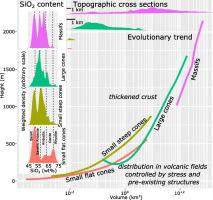Journal of Volcanology and Geothermal Research ( IF 2.4 ) Pub Date : 2021-04-19 , DOI: 10.1016/j.jvolgeores.2021.107251 Engielle Mae Paguican , Pablo Grosse , Gareth N. Fabbro , Matthieu Kervyn

|
The Philippine Island Arc has a large number of volcanoes with diverse morphologies, making it an ideal location to study the factors controlling the morphology and spatial distribution of island arc volcanoes. We have identified 731 volcanic edifices using the SRTM 30 m digital elevation model, and computed their quantitative morphology using the MORVOLC algorithm. Hierarchical classification by principal component (PC) analysis distinguishes four volcano types: small flat cones, small steep cones, large cones, and massifs, with mean volumes of 0.2 km3 (<6.2 km3), 0.4 km3 (<9 km3), 29 km3 (0.15–178 km3), 267 km3 (76–675 km3), mean heights of 125 m (16–721 m), 260 m (53–971 m), 842 m (59–2313 m), 1533 m (1012–2175 m), and mean slopes of 13° (3–21°), 22° (14–37°), 15° (3–28°), 15° (11–22°), respectively. This classification is based mainly on their size and irregularity (PC1) and steepness (mean slope and height/basal width ratio; PC2), and to a lesser extent on the size of the summit region and edifice truncation (PC3) and edifice elongation (PC4). These morphological volcano classes represent stages along an evolutionary trend. The small flat cones are mostly monogenetic, whereas the small steep cone class represents an early growth stage. Some can develop into large polygenetic cones while a few can further grow laterally into massifs, both of which are preferentially found on thickened crust. There is a trend towards more silicic compositions from small to large cones, perhaps due to larger edifice loads preventing mafic dykes from reaching the surface. The distribution and alignment of the edifices within volcanic fields seems to be influenced by both regional and local stress fields and pre-existing structures.
中文翻译:

菲律宾火山形态分类及空间分布
菲律宾岛弧火山数量众多,形态多样,是研究岛弧火山形态和空间分布控制因素的理想地点。我们使用 SRTM 30 m 数字高程模型识别了 731 座火山建筑物,并使用 MORVOLC 算法计算了它们的定量形态。通过主成分 (PC) 分析的层次分类区分了四种火山类型:小平锥、小陡锥、大锥和地块,平均体积为 0.2 km 3 (<6.2 km 3 )、0.4 km 3 (<9 km 3 ), 29 km 3 (0.15–178 km 3 ), 267 km 3 (76–675 km 3),平均高度为 125 m (16–721 m)、260 m (53–971 m)、842 m (59–2313 m)、1533 m (1012–2175 m),平均坡度为 13° (3– 21°)、22°(14-37°)、15°(3-28°)、15°(11-22°)。这种分类主要基于它们的大小和不规则度(PC1)和陡度(平均坡度和高度/基底宽度比;PC2),在较小程度上基于顶峰区域的大小和建筑物截断(PC3)和建筑物伸长率( PC4)。这些形态火山类别代表沿进化趋势的阶段。小扁锥体大多是单基因的,而小陡锥体代表早期生长阶段。有些可以发展成大的多基因锥,而有些可以进一步横向生长成地块,两者都优先在加厚的地壳上发现。从小锥体到大锥体都有更多硅质成分的趋势,这可能是由于更大的建筑物负载阻止了镁铁质岩脉到达地表。火山场内建筑物的分布和排列似乎受到区域和局部应力场以及预先存在的结构的影响。











































 京公网安备 11010802027423号
京公网安备 11010802027423号